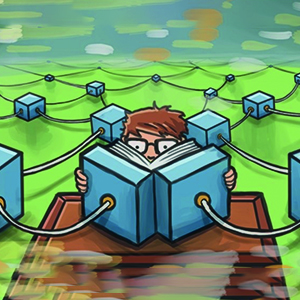6 ways Blockchain could be used in Education
 Recently the two terms- Blockchain and Bitcoin have been declared as the buzzword of the year. To define blockchain in simple words, it’s nothing but a platform that allows people to create digital property independently of third parties and belief-based methods of recording ownership. The idea is to create a security and trust, cutting out the need for a middleman to validate transactions. Along with all other sectors, as of now, blockchain is emerging as a next big thing in education, a handful of academics and institutions already started experimenting with ways that blockchain can be used in higher education. Few of the areas where blockchain is supposed to be practiced in transforming education can be discussed below-
Recently the two terms- Blockchain and Bitcoin have been declared as the buzzword of the year. To define blockchain in simple words, it’s nothing but a platform that allows people to create digital property independently of third parties and belief-based methods of recording ownership. The idea is to create a security and trust, cutting out the need for a middleman to validate transactions. Along with all other sectors, as of now, blockchain is emerging as a next big thing in education, a handful of academics and institutions already started experimenting with ways that blockchain can be used in higher education. Few of the areas where blockchain is supposed to be practiced in transforming education can be discussed below-
Apprenticeships: Needless to say, Vocational Education is one of the most important parts of Indian Education today. Instead of relying heavily on purely academic institutions to deliver education, VE enables the students to acquire learning at home. However, the process and certification in VE is a complex and daunting job. In this scene, blockchain can help greatly by marinating a national database which will not be only reliable but also less time-consuming.
Global Assessment: The current paper system of certifications is quite tiring. With an increasingly mobile population of students, a centralized database of credentials and achievements will be of great help. Certificates can be just stored in the blockchain platform without wasting time in paper works.
Keeping Records safe: There are students from war-torn areas intending to continue their education elsewhere, and students of a school whose server breaks down or the data completely wiped out, for some reason. These and others who have trouble getting a copy of their school records can benefit from blockchain-encrypted credentials. Some sort of secure, online repository would be helpful.
Getting Hired: As Blockchain uses public key infrastructure (PKI) for establishing a secure platform, if enough people put their qualifications on to the blockchain, employers could simply filter candidates who have studied the desired subjects and flagged themselves as wanting a new role. Advertising the position, and filtering out candidates by reading endless CVs – which can take days of managers’ time would no longer be necessary.
The Entrance of ‘Smart Contracts’: The set up of smart contracts enable an agreement if certain conditions are met. For instance, if a student who is receiving financial assistance to study, this could mean that they only receive funding once they submit compulsory coursework. By entering a publication on a blockchain, a smart contract can be set up so that the giver receives automatic recognition or even payment for citations.
Copyright of Educational Content: The contents created by educators around the world can be saved published openly on blockchain while keeping track of re-use. The creators of the content can simply announce the publication of their resources and coin could be awarded to educators according to the level of reuse of their respective resources.

